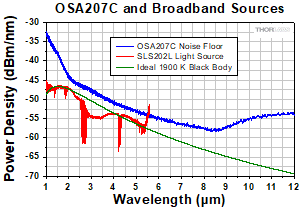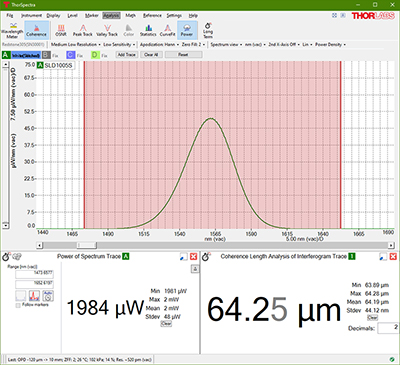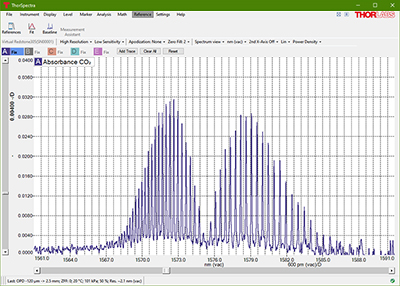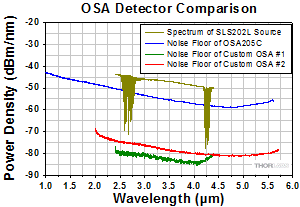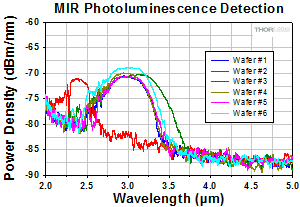
Optical Spectrum Analyzers
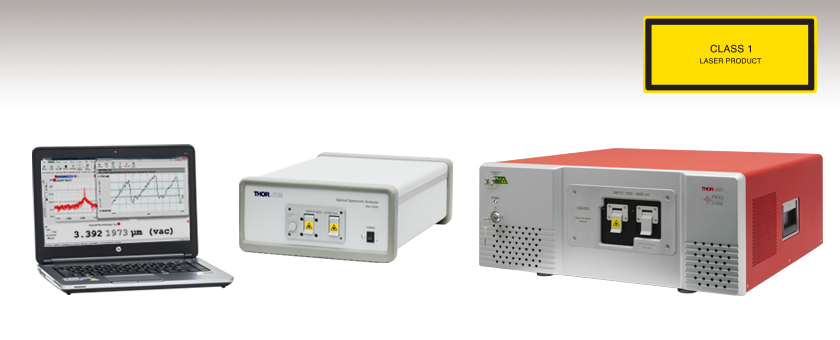
- Dual-Function Broadband Spectrometer and Wavelength Meter
- 1.9 GHz or 7.5 GHz Resolution Models
- Seven Models Available for Wavelengths from 250 nm to 12.0 µm
- FC/PC Fiber Connector and Free-Space Optical Inputs
OSA202C
600 - 1700 nm,
7.5 GHz Resolution
All OSAs include a Windows® laptop with our data collection and analysis software.
Redstone® OSA305
1.0 µm - 5.6 µm,
1.9 GHz Resolution
OVERVIEW
Pre-Purchase Support and Customization
To help ensure that our Optical Spectrum Analyzers will meet your application needs, we would be pleased to provide the following:
- Demo Units for Trial Use in Your Lab
- Example Measurements
- Evaluation of Suitability for Your Application
- "Virtual Device" Software Demo (See the
Software Tab)
We also invite customers whose needs are not addressed by the OSA models below to work with our engineering and manufacturing team to tailor an application-specific unit. Examples of customization options include:
- Different Input Receptacle
- Small Adjustments to the Wavelength Range
- Extra Test Protocols
- Shipping Without a Laptop
If you would like to take advantage of any of these services, or if you have feedback or questions, I'd be happy to assist!
| Quick Comparisona | ||
|---|---|---|
| Item # | OSA20xC | Redstone® OSA30x |
| Noise Floorb | Absolute Power Power Density |
|
| Resolution (pm)c | Click to Enlarge |
|
| Spectral Resolution | 7.5 GHz (0.25 cm-1) | 1.9 GHz (0.063 cm-1) |
| Spectral Accuracy | ±2 ppm | ±0.2 ppm |
| Wavelength Meter Accuracy | ±1 ppm | ±0.5 ppm |
| Power Level Accuracy | ±1 dB | ±0.4 dB |
| Optical Rejection Ratio | 30 dB | 40 dB |
| Polarization Dependence | ±1 dB | ±0.2 dB (OSA302) ±0.1 dB (OSA305) |
| Free-Space Input (Collimated Beams) |
≤Ø6 mm | ≤Ø10 mm |
| Input Fiber Compatibility | FC/PC Connectors as Standard | |
| Dimensions | 320.3 mm x 149.2 mm x 474.7 mm (12.61" x 5.88" x 18.69") |
541.0 mm x 224.1 mm x 532.6 mm (21.30" x 8.82" x 20.97") |
| Weight | 20 lbs (10 kg) | 58.4 lbs (26.5 kg) |
| Feature Comparison | ||
| Alignment Laser |  |
 |
| Optional Purging |  |
 |
| GUI with Analysis Tools |  |
 |
| Accessible Calibration Laser | - |  |
| External Trigger | - |  |
| Multi-Detector Configuration | - |  |
| Piezoelectric Beam Path Optimization |
- |  |
Features
- General-Purpose (OSA20xC) and High-Performance (Redstone® OSA30x) Instruments Available
- Spectrometer Mode Resolution
- Wavelength Meter Mode Resolution: 0.1 ppm (Only for <10 GHz Linewidth Sources)
- Spectrum Obtained Using Michelson Interferometer and Fourier Transform
- Free-Space (with Cage Compatibility) and FC/PC Fiber-Coupled Inputs
- Operated by Included Windows® Laptop with Pre-Installed Software
-
- Straightforward, Intuitive, and Responsive Interface
- Real-Time Math Operations and Statistical Analysis
Thorlabs' Optical Spectrum Analyzers (OSAs) perform highly accurate spectral measurements. Compatible with fiber-coupled and free-space light sources, these benchtop instruments suit a wide variety of applications, such as analyzing the spectrum of a telecom signal, resolving the Fabry-Perot modes of a gain chip, identifying gas absorption lines, and analyzing the output from a photonic integrated circuit (PIC) as part of a PIC testing station. We offer two instrument types: the general-purpose OSA20xC instruments, which have a high update rate and moderate resolution, and the high-performance Redstone® OSA30x instruments, which have a high dynamic range and high resolution.
Our optical spectrum analyzers acquire the spectrum via Fourier transform, using a scanning Michelson interferometer. This approach enables a high-precision Wavelength Meter mode with seven significant figures and ±1 part-per-million (ppm) spectral precision, allows robust statistical analysis of the acquired spectra, and provides broadband spectral measurements with every scan. A frequency-stabilized 632.9918 nm HeNe alignment laser is included in each OSA20xC unit, which is used to ensure a spectral accuracy of ±2 ppm. Each Redstone OSA includes a frequency-locked 1532.8323 nm reference laser, resulting in a spectral accuracy down to ±0.2 ppm.
Thorlabs' OSA20xC spectrum analyzers are optimized to cover five different spectral ranges with a spectral resolution of 7.5 GHz (0.25 cm-1) and a 30 dB optical rejection ratio. Designed for applications that require higher optical resolutions or sensitivities, the Redstone OSAs feature two detectors, which allow for measurements over a wide wavelength range with a 1.9 GHz (0.063 cm-1) spectral resolution, as well as a noise floor with a 40 dB optical rejection ratio. For additional details on the interferometer design, please see the Design tab.
These instruments are designed to measure CW light sources. They also work in some applications where a pulsed light source is used; details may be found on the Pulsed Sources tab. Similarly, our OSA instruments are not designed for applications where it is necessary to recover small signals, including fluorescence detection and Raman spectroscopy. If your application would benefit from increased detection sensitivity, please refer to the Custom OSAs tab for some of our capabilities.
Optical Inputs
All of Thorlabs' OSAs accept FC/PC-terminated fiber patch cables and collimated free-space beams up to Ø6 mm (OSA20xC) or Ø10 mm (Redstone OSA30x). Details on compatibility are in the Specs and Free-Space Coupling tabs; example setups with fiber-coupled and free-space inputs are shown in the PIC Testing Demo and Gas Spectroscopy tabs, respectively. For wavelengths from 2 µm to 5.5 µm, we offer fluoride single mode and fluoride multimode fiber patch cables. Optical Spectrum Analyzers with other fiber input receptacles are available by contacting Tech Support.
Software
Each Optical Spectrum Analyzer includes a Windows® laptop with our OSA software suite pre-installed. This software includes built-in tools for simple and complex analysis, controls for adjusting sensitivity and resolution, a wavelength meter tool for narrowband sources, and a coherence length tool for broadband sources. Also available are apodization functions, which are used to account for the finite path length over which the interferogram is measured. This software also includes built-in support for the HITRAN reference database for spectroscopic analysis. For additional details on software capabilities, please see the Software tab.
Application Note
Due to its broad wavelength responsivity, the OSA207C's noise floor is higher than that of our other Optical Spectrum Analyzers, which achieve lower noise floors at the expense of having narrower wavelength ranges. This OSA will easily detect lasers and other narrowband sources, but many broadband sources will not have sufficient power spectral density to be detected. This plot compares the OSA207C's noise floor in Power Density mode to an ideal 1900 K black body and Thorlabs' SLS202La Stabilized Broadband Light Source (which was measured with an OSA205C).
SPECS
| Item # | OSA201C | OSA202C | OSA203C | OSA205C | OSA207C |
|---|---|---|---|---|---|
| Wavelength Rangea | 350 - 1100 nm | 600 - 1700 nm | 1.0 - 2.6 µmb (10 000 - 3846 cm-1) |
1.0 - 5.6 µm (10 000 - 1786 cm-1) |
1.0 - 12.0 µm (10 000 - 833 cm-1) |
| Level Sensitivityc,d |
-50 dBm/nme (350 - 500 nm) -60 dBm/nm (500 - 1100 nm) |
-65 dBm/nm (600 - 700 nm) -70 dBm/nm (700 - 1700 nm) |
-70 dBm/nmf |
-40 dBm/nm | -30 dBm/nm (1.0 - 2.0 µm) -40 dBm/nm (2.0 - 12.0 µm) |
| Free-Space Window Material |
Uncoated CaF2 | Uncoated ZnSe | |||
| Operating Temperature | 10 °C to 40 °C | 10 °C to 35 °C | |||
| Item # | Redstone® OSA302 | Redstone OSA305 |
|---|---|---|
| Wavelength Rangea | 250 nm - 2.5 µmb (40 000 - 4000 cm-1) |
1.0 - 5.6 µm (10 000 - 1786 cm-1) |
| Level Sensitivityc,d | -50 dBm/nm (250 - 1500 nm) -70 dBm/nm (1500 - 2500 nm) |
-65 dBm/nm (1.0 - 1.5 µm) -70 dBm/nm (1.5 - 5.6 µm) |
| Free-Space Window Material |
Uncoated CaF2 | |
| Operating Temperature | 10 °C to 40 °C | |
| General Specificationsa | ||||
|---|---|---|---|---|
| Item # | OSA20xC | Redstone OSA30x | Notes | |
| Spectral Resolutionb | 7.5 GHz (0.25 cm-1) See Figure 2.1 |
1.9 GHz (0.063 cm-1) See Figure 2.1 |
Spectrometer Mode | |
| Spectral Accuracyc | ±2 ppmd | ±0.2 ppmd | ||
| Spectral Precisione | 1 ppmd | 0.2 ppmd | ||
| Wavelength Meter Resolutionf | 0.1 ppmd | Wavelength Meter Mode (Linewidth < 10 GHz) |
||
| Wavelength Meter Display Resolutionf,g |
9 Decimals | |||
| Wavelength Meter Accuracyc,f | ±1 ppmd | ±0.5 ppmd | ||
| Wavelength Meter Precisionf,h | 0.2 ppmd | |||
| Input Power (Max) | 10 mW (10 dBm) | CW Source | ||
| Input Damage Thresholdi | 20 mW (13 dBm) | - | ||
| Power Level Accuracyj | ±1 dB | ±0.4 dB | - | |
| Optical Rejection Ratiok | 30 dB | 40 dB | See the Design Tab for Details |
|
| Polarization Dependence | ±1 dB | ±0.2 dB (OSA302) ±0.1 dB (OSA305) |
- | |
| Internal Source Specifications | ||||
| Source Type | Frequency-Stabilized Laser (Alignment and Reference Laser) |
Alignment Laser | Frequency-Locked Reference Laser |
- |
| Wavelength | 633 nm | 636 nm | 1.53 µm | - |
| Maximum Output Power | <80 µW | <100 µW | <10 mW | - |
| Beam Divergence | 0.2 rad | 0.2 rad | 0.2 rad | Approximate Value |
| Trigger Specifications | ||||
| Trig, AUX In | N/A | Schmitt Trigger Input with 10 kΩ Pull-Up Resistor to +5 V Positive-Going Threshold Voltage, Min: 1.3 V Max: 2.5 V Negative-Going Threshold Voltage, Min: 0.6 V Max: 1.8 V Hysteresis Voltage, Min: 0.4 V Max: 1.5 V Maximum Input Voltage: +5.5 V |
- | |
| Acquiring Data, AUX Out | N/A | LOW-Level Output Voltage Max 0.1 V (I ≤ 100 µA) HIGH-Level Output Voltage Min 4.7 V (I ≤ 100 µA) |
- | |
| Interlock Specifications | ||||
| Interlock Switch Requirements | N/A | Must be Normally Open Dry Contacts, Apply No External Voltages to the Interlock Input |
- | |
| Type of Connector | N/A | 2.5 mm Mono Phono Jack | - | |
| Open Circuit Voltage | N/A | 5 VDC | - | |
| Short Circuit Current | N/A | 0.5 mA | Typical | |
| Physical Specifications | ||||
| Input Fiber Compatibility | FC/PC Connectorsl All Single Mode Fiber Patch Cables, Including Fluoride SM Fiber Patch Cables Standard and Hybrid Multimode Fiber Patch Cables with ≤Ø50 µm Core and NA ≤ 0.22 Fluoride Multimode Fiber Patch Cables with ≤Ø100 µm Core and NA ≤ 0.26 (Single Mode Patch Cables Provide the Highest Contrast) |
- | ||
| Free-Space Input | Accepts Collimated Beams up to Ø6 mm Red Alignment Laser Beam Output (Class 1) Four 4-40 Taps for 30 mm Cage Systems |
Accepts Collimated Beams up to Ø10 mm Red Alignment Laser Beam Output (Class 1) Four 4-40 Taps for 60 mm Cage Systems |
- | |
| Free-Space Input Beam Height |
61 mm (2.4") When Using the Included Mounting Feet |
117.3 mm (4.62") | - | |
| Dimensions | 320.3 mm x 149.2 mm x 474.7 mm (12.61" x 5.88" x 18.69") |
541.0 mm x 224.1 mm x 532.6 mm (21.30" x 8.82" x 20.97") |
- | |
| Absolute Maximum Ratings | ||||
| Input Powerm | 100 - 240 VAC, 47 - 63 Hz, 250 W (Max) | - | ||
| Relative Humidity | <80%, Non-Condensing | - | ||
| Storage Temperature | -10 °C to 60 °C | - | ||
| Optical CW Power (Max)i | 20 mW (13 dBm) |
Limited by Damage Threshold of Internal Components |
||
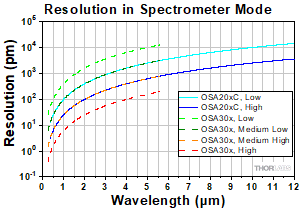
Click to Enlarge
Figure 2.1 The resolution shown here was calculated using the formula explained in the Design tab. Although the formula is valid for all OSA models, the usable wavelength range of each model is limited by the bandwidth of the detectors and optical coatings. Note that the resolution is valid only for the specified wavelength range of the instrument.
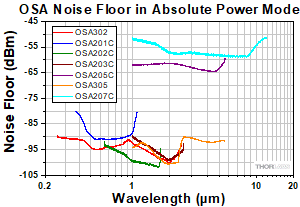
Click to Enlarge
Figure 2.2 Absolute Power mode is recommended for narrowband sources. The OSA203C noise floor was measured in low-temperature mode.
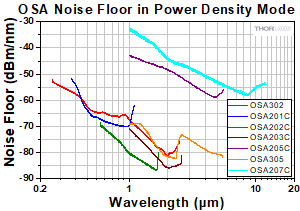
Click to Enlarge
Figure 2.3 Power Density mode is recommended for broadband sources. The OSA203C noise floor was measured in low-temperature mode.
Data Acquisition Specifications
The scan sensitivity and resolution are two independent settings controlled from the software. The sensitivity setting modifies the range of detector gain levels, while the resolution setting changes the optical path difference (OPD). For more details, see the Design tab.
| OSA20xC Series Time Between Updates (Update Frequency) | ||
|---|---|---|
| Sensitivity | Resolution | |
| Low | High | |
| Low | 0.5 s (1.9 Hz) | 1.8 s (0.6 Hz) |
| Medium Low | 0.8 s (1.2 Hz) | 2.9 s (0.3 Hz) |
| Medium High | 1.5 s (0.7 Hz) | 5.2 s (0.2 Hz) |
| High | 2.7 s (0.4 Hz) | 9.5 s (0.1 Hz) |
| OSA30x Time Between Updates (Update Frequency) | ||||
|---|---|---|---|---|
| Sensitivity | Resolution | |||
| Low | Medium Low | Medium High | High | |
| Low | 1.6 s (0.64 Hz) | 2.0 s (0.51 Hz) | 3.7 s (0.27 Hz) | 9.5 s (0.11 Hz) |
| Medium | 3.1 s (0.32 Hz) | 4.1 s (0.24 Hz) | 8.6 s (0.12 Hz) | 23 s (0.04 Hz) |
| High | 7.8 s (0.13 Hz) | 10 s (0.10 Hz) | 22 s (0.05 Hz) | 63 s (0.02 Hz) |
DESIGN
Design
This tab describes the key concepts and implementation of the design used in Thorlabs' Fourier Transform Optical Spectrum Analyzers.
Contents- Interferometer Design
- Resolution and Sensitivity
- Absolute Power and Power Density
- Interferogram Data Acquisition
- Interferogram Data Processing
- Wavelength Meter Mode
- Wavelength Calibration and Accuracy
- Optical Rejection Ratio
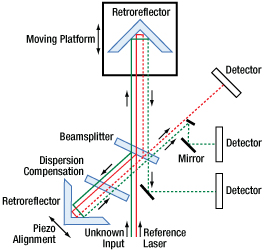
Click to Enlarge
Figure 3.2 Schematic of the optical path in Thorlabs' Redstone OSA30x. Note that the OSA302 does not include the dispersion compensation plate in the interferometer.
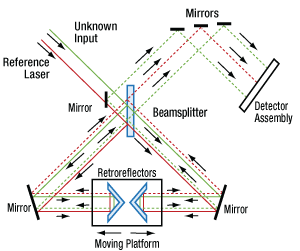
Click to Enlarge
Figure 3.1 Schematic of the optical path in Thorlabs' OSA20xC OSAs, detailing the dual retroreflector design.
Interferometer Design
Thorlabs' OSA20xC Fourier Transform Optical Spectrum Analyzers (FT-OSA) utilize two retroreflectors, as shown in Figure 3.1. These retroreflectors are mounted on a voice-coil-driven platform, which dynamically changes the optical path length of the two arms of the interferometer simultaneously and in opposite directions. The advantage of this layout is that it changes the optical path difference (OPD) of the interferometer by four times the mechanical movement of the platform. The longer the change in OPD, the finer the spectral detail the FT-OSA can resolve.
The Redstone® OSA302 and OSA305 FT-OSAs use a standard arrangement of one fixed and one movable retroreflector as shown in Figure 3.2. The mobile retroreflector is mounted on Thorlabs' patented voice-coil-driven platform*, which changes the optical path length of the branch. The fixed retroreflector is mounted on a piezo actuator that translates the retroreflector in the two dimensions orthogonal to the beam path in a self-alignment algorithm. This configuration changes the OPD between the two branches by twice the mechanical movement of the platform.
*The Redstone OSA30x is constructed using Thorlabs' patented voice-coil-driven platform design.
After collimating the unknown input, a beamsplitter divides the optical signal into two separate paths. The path length difference between the two paths is varied up to 40 mm for the OSA20xC and 160 mm for the Redstone OSA30x. The collimated light fields then optically interfere as they recombine at the beamsplitter.
The detector assemblies shown in Figures 3.1 and 3.2 record the interference pattern, commonly referred to as an interferogram. This interferogram is the autocorrelation waveform of the input optical spectrum. By applying a Fourier transform to the waveform, the optical spectrum is recovered. Note that the Redstone OSA models collect asymmetrical interferograms in terms of the location of the point of zero path difference (ZPD), and these interferograms are usually called single-sided; the OSA20xC instruments collect double-sided interferograms. The resulting spectrum offers both high resolution and very broad wavelength coverage with a spectral resolution that is related to the optical path difference. The wavelength range is limited by the bandwidth of the detectors and optical coatings. The accuracy of our systems is ensured by including a frequency-stabilized 632.9918 nm HeNe reference laser in the OSA20xC models and a frequency-locked 1532.8323 nm infrared reference laser in the Redstone OSA30x models. The reference laser is inserted into the interferometer and closely follows the same path traversed by the unknown input light field. This reference laser provides highly accurate, interferometric measurements of beam path length changes, allowing the systems to continuously self-calibrate and ensure accurate optical analysis well beyond what is possible with a grating based OSA.
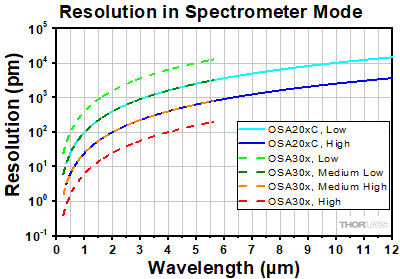
Click to Enlarge
Figure 3.3 OSA Resolution vs. Wavelength of the Unknown Input
The resolution shown here was calculated using formula (1). Although the formula is valid for all OSA models, the usable wavelength range of each model is limited by the bandwidth of the detectors and optical coatings. Note that for the OSA20xC instruments, Δk = 1 cm-1 for Low Resolution Mode and Δk = 0.25 cm-1 for High Resolution Mode. For the Redstone OSA30x models, Low, Medium Low, Medium High, and High Resolutions correspond to Δk's of 4.0, 1.0, 0.25, and 0.063 cm-1, respectively. Note that the resolution is valid only for the specified wavelength range of the instrument.
The OSA20xC and Redstone OSAs have spectral resolutions of 7.5 GHz (0.25 cm-1) and 1.9 GHz (0.063 cm-1), respectively. The resolution in units of wavelength is dependent on the wavelength of light being measured. For more details, see the Resolution and Sensitivity section. In this context, the spectral resolution is defined according to the Rayleigh criterion and is the minimum separation required between two spectral features in order to resolve them as two separate lines. These spectral resolution numbers should not be confused with the resolution when operating in the Wavelength Meter mode, which is considerably better.
To reduce the presence of water absorption lines in the MIR region of the spectrum, our OSAs feature two 1/4" ID quick-connect hose connections on the back panel, through which the interferometer can be purged with dry air or nitrogen. Our Pure Air Circulator Unit, which uses hosing that can be directly inserted into these connectors, is ideal for this task.
Resolution and Sensitivity
The resolution of this type of instrument depends on the optical path difference (OPD) between the two paths in the interferometer. It is usually easier to understand the resolution in terms of wavenumbers (inverse centimeters), as opposed to wavelength (nanometers) or frequency (terahertz).
Assume we have two narrowband sources, such as lasers, with a 1 cm-1 energy difference, 6500 cm-1 and 6501 cm-1. To distinguish between these signals in the interferogram, we would need to move away 1 cm from the point of zero path difference (ZPD). The OSA20xC can move ±4 cm in OPD and thus spectral features 0.25 cm-1 apart can be resolved, while the Redstone OSA30x can move 16 cm in OPD and resolve spectral features that are 0.063 cm-1 apart. The resolution of the instrument can be calculated as:

where Δλ is the resolution in pm, Δk is the resolution in cm-1, and λ is the wavelength in µm. The resolution in pm as a function of wavelength, converted using formula (1), is shown in Figure 3.3.
The resolution of the OSA20xC instru ments can be set to High or Low in the main window of the software. In high resolution mode, the retroreflectors translate by the maximum of ±1 cm (±4 cm in OPD), while in low resolution mode, the retroreflectors translate by ±0.25 cm (±1 cm in OPD). The Redstone OSA30x instruments can be set to one of four resolution modes: High, Medium High, Medium Low, or Low. These settings correspond to OPDs of 16 cm, 4 cm, 1 cm, and 2.5 mm, respectively. The OSA software can cut the length of the interferogram that is used in the calculation of the spectrum in order to remove spectral contributions from high-frequency components.
The sensitivity of the instrument depends on the electronic gain used in the sensor electronics. Since an increased gain setting reduces the bandwidth of the detectors, the instrument will run slower when higher gain settings are used. Figures 3.4 and 3.5 show the dependency of the noise floor on the wavelength and OSA model.
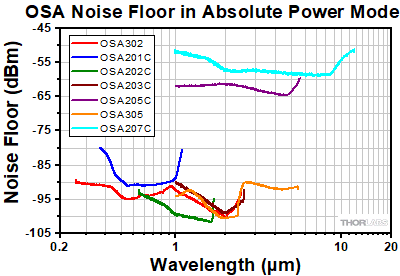
Click to Enlarge
Figure 3.4 Noise Floor in Absolute Power Mode
Absolute Power mode is recommended for narrowband sources. The OSA203C noise floor was measured in low-temperature mode.
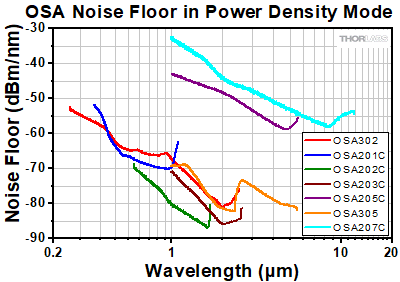
Click to Enlarge
Figure 3.5 Noise Floor in Power Density Mode
Power Density mode is recommended for broadband sources. The OSA203C noise floor was measured in low-temperature mode.
Absolute Power and Power Density
The vertical axis of the spectrum can be displayed as Absolute Power (Figure 3.4) or Power Density (Figure 3.5), both of which can be displayed in either a linear or logarithmic scale. In Absolute Power mode, the total power displayed is based on the actual instrument resolution for that specific wavelength; this setting is recommended to be used only with narrow spectrum input light. For broadband devices, it is recommended that the Power Density mode is used. Here the vertical axis is displayed in units of power per unit wavelength, where the unit wavelength is based upon a fixed wavelength band and is independent of the resolution setting of the instrument.
Interferogram Data Acquisition
For the OSA20xC models, the interference pattern of the reference laser is used to clock a 16-bit analog-to-digital converter (ADC) such that samples are taken at a fixed, equidistant optical path length interval. The HeNe reference fringe period is digitized and its frequency multiplied by a phase-locked loop (PLL), leading to an extremely fine sampling resolution. Multiple PLL filters enable frequency multiplication settings of 16X, 32X, 64X, or 128X. At the 128X multiplier setting, data points are acquired approximately every 1 nm of carriage travel. The multiple PLL filters enable the user to balance the system parameters of resolution and sensitivity against the acquisition time and refresh rate.
The Redstone OSA30x instruments instead sample the interferogram at a fixed frequency of up to 1 MHz with an 18-bit ADC while the retroreflector platform moves at a constant speed controlled by a PID loop. At the highest sensitivity setting, there is one data point collected about every 1 nm of travel. The collected data is resampled to fit up to 128 data points per reference laser period.
The fine sampling can be very useful when the measured light is weak and broadband, causing only a very short interval in the interferogram at the ZPD to contain all the spectral information. This portion of the interferogram is normally referred to as the center burst.
A high-speed USB link transfers the interferograms to the OSA software, which is highly optimized to take full advantage of modern multi-core processors, as well as top-performing graphics processing units (GPUs). The software performs a number of calculations to analyze and condition the input waveform in order to obtain the highest possible resolution and signal-to-noise ratio (SNR) at the output of the Fast Fourier transform (FFT).
The OSA20xC devices make use of a very low noise and low distortion detector amplifier with automatic gain control provides a large dynamic range, allows optimal use of the ADC, and ensures excellent signal-to-noise (SNR) for up to 10 mW of input power. For low-power signals, the system can typically detect less than 100 pW from narrowband sources. The balanced detection architecture enhances the SNR of the system by enabling the OSA20xC to use all of the light that enters the interferometer, while also rejecting common mode noise.
The Redstone OSA detector modules contain high gain-bandwidth product (GBP) amplifiers, which fully exploit the detectors’ dynamic range, combined with high-current low-noise buffers driving a high-bandwidth 18-bit ADC. Automatic amplifier adjustments optimize the number of used ADC bits (filling ratio). Switchable optical attenuators provide for a wide input power range even with early saturating IR-detectors. Differential amplifiers, as well as balanced transmission architectures with effective screening and filtering techniques, assure a good signal integrity for a high spurious-free dynamic range.
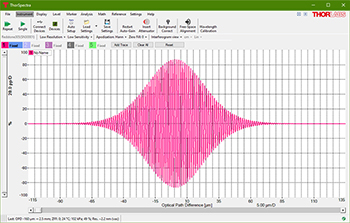
Click to Enlarge
Figure 3.6 A Typical Interferogram
Interferogram Data Processing
The interferograms (see Figure 6) generated by the instrument vary from 50 thousand to 16 million data points depending on the resolution and sensitivity mode settings employed. The FT-OSA software analyzes the input data and intelligently selects the optimal FFT algorithm from our internal library.
Additional software performance is realized by utilizing an asynchronous, multi-threaded approach to collecting and handling interferogram data through the multitude of processing stages required to yield spectrum information. The software's multi-threaded architecture manages several operational tasks in parallel by actively adapting to the PC's capabilities, thus ensuring maximum processor bandwidth utilization. Each of our FT-OSA instruments ships complete with a laptop computer that has been carefully selected to ensure that both the data processing and user interface operate optimally.
Wavelength Meter Mode
When narrowband optical signals are analyzed, the FT-OSA automatically calculates the center wavelength of the input, which can be displayed in a window just below the main display that presents the overall spectrum. The central wavelength, λ, is calculated by counting interference fringes (periods in the interferogram) from both the input and reference lasers according to formula (2):

Here, mref is the number of fringes for the reference laser, mmeas is the number of fringes from the input laser, nref is the index of refraction of air at the reference laser wavelength (632.9918 nm or 1532.8323 nm), and λref,vac is the vacuum wavelength of the reference laser. nmeas is the index of refraction of air at the wavelength λmeas,vac and is determined iteratively from λmeas,air (that is, the measured wavelength in air) using a modified version of the Edlén formula (OSA software version 2.90 or lower) or Ciddor's formula (OSA software version 3.00 or higher).
The resolution of the FT-OSA operating as a wavelength meter is substantially higher than the system when it operates as a broadband spectrometer because the system can resolve a fraction of a fringe (see the Interferogram Data Acquisition section). In practice, the resolution of the system is limited by the bandwidth and structure of the unknown input, noise in the detectors, drift in the reference laser, interferometer alignment, and other systematic errors. In Wavelength Meter mode, the system has been found to offer reliable results as low as ±0.1 pm in the visible spectrum and ±0.2 pm in the NIR/IR (see the Specs tab for details).
The software evaluates the spectrum of the unknown input in order to determine an appropriate display resolution. If the data is unreliable, as would be the case for a multiple peak spectrum, the software disables the Wavelength Meter mode so it does not provide misleading results.
Wavelength Calibration and Accuracy
The OSA20xC instruments use a built-in stabilized HeNe reference laser with a vacuum wavelength of 632.9918 nm. The use of a stabilized HeNe ensures long-term wavelength accuracy as the dynamics of the stabilized HeNe are well-known and controlled. The Redstone OSA30x incorporates a frequency-locked reference laser with a vacuum wavelength of 1532.8323 nm. Because of the frequency-lock, long-term wavelength accuracy is ensured, and the reference laser is connected to an FC/APC output and can be fed into the instrument fiber input for additional calibration if so desired.
The instrument is factory-aligned so that the reference and unknown input beams experience the same optical path length change as the interferometer is scanned. The effect of any residual alignment error on wavelength measurements is less than 0.5 ppm; the input beam pointing accuracy is ensured by a high-precision ceramic receptacle and a robust interferometer cavity design. No optical fibers are used within the scanning interferometer. The wavelength of the reference laser in air is actively calculated for each measurement using the Edlén formula (OSA software version 2.90 or lower) or Ciddor's formula (OSA software version 3.00 or higher) with temperature and pressure data collected by sensors internal to the instrument.
| Table 3.7 Optical Rejection Ratio | ||
|---|---|---|
| Distance from 1532 nm Peak | OSA205C | OSA305 |
| 0.2 nm (25 GHz) | 30 dB | 40 dB |
| 0.8 nm (100 GHz) | 37 dB | 42 dB |
| 6.2 nm (800 GHz) | 44 dB | 45 dB |
| 7.8 nm (1000 GHz) | 44 dB | 45 dB |
Optical Rejection Ratio
The ability to measure low-level signals close to a peak is determined by the optical rejection ratio (ORR) of the instrument. It can be seen as the filter response of the OSA and can be defined as the ratio of the power at a peak of interest to the power at a given distance from said peak. For Thorlabs' OSAs, the ORR is defined with a stricter condition: instead of just considering the power at a single data point, e.g., 25 GHz from the peak, the power of the highest noise in the wavelength range from 25 GHz to 2 THz is related to the power of the peak. This way, any additional limiting peaks that are not located at the test distances will still be included in the ORR value:
![]()
If the ORR is not higher than the optical signal-to-noise ratio of the source to be tested, the measurement will be limited by the OSA's response, rather than reflecting a true property of the tested source. Table 3.7 provides an example.
FREE-SPACE COUPLING

Click to Enlarge
Figure 4.3 The underside of the OSA has M4-tapped holes that accept the three mounting feet included with the unit (see the Shipping List tab).

Click to Enlarge
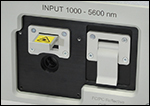
Click to Enlarge
Figure 4.1 The free-Space optical input on the Redstone OSA30x accepts collimated beams with ≤Ø10 mm beam diameter.
Directly Compatible with Free-Space Beams
Thorlabs' OSAs each include a free-space optical input aperture, allowing them to directly accept collimated beams up to a maximum beam size of Ø6 mm (OSA20xC) or Ø10 mm (Redstone® OSA30x). To align the input light source with respect to the OSA's internal interferometer, a red, Class 1 alignment beam is emitted from the aperture; the alignment beam is activated by rotating a switch on the OSA20xC front panel or by a button in the OSA software for the Redstone*. The input source should be made collinear to the alignment beam for the OSA to provide optimal measurement accuracy. Four 4-40 taps around the input aperture enable compatibility with our 30 mm cage system (OSA20xC) or 60 mm cage system (Redstone OSA30x); use cage rods no shorter than 1.5" to prevent attached cage components from clashing with the door.
The OSA20xC interferometer assembly normally "floats" on gel bushings inside the case. When using the free-space input, it may be desirable to lock the interferometer to the optical table surface. This can be accomplished by using the provided mounting feet (see the Shipping List tab) to secure the OSA using two of Thorlabs' CF175C(/M) clamping forks, as illustrated in Figure 4.3. Likewise, even though the Redstone OSA30x is rigid and does not float, it is recommended to use two or more clamping forks when using the free-space input.
When the OSA20xC interferometers are locked to an optical table, the beam height is 61 mm (2.4") from the table surface. The Redstone OSA30x free-space input accepts a beam height of 117 mm (4.6") above the table surface. To adjust the input beam height to that of the OSA's input, we recommend using Thorlabs' RS99(/M) Periscope Assembly or a periscope constructed with our DP14A(/M) Damped Post.
We recommend only using the posts supplied with the OSA to secure it to the optical table. Other posts, such as our Ø1/2" optical posts, should not be used to secure the OSA; they will not provide adequate support because the OSA20xC and Redstone OSA30x weigh 20 lbs (10 kg) and 58.4 lbs (26.5 kg), respectively. We also do not recommend using long optical posts to raise the OSA off of the optical table surface.
*Additional details for free-space alignment with the Redstone can be found in the application note here.
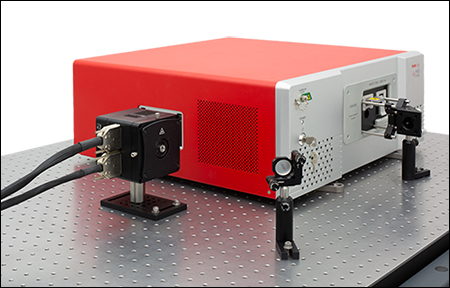
Click to Enlarge
Figure 4.4 A Redstone OSA305 secured to an optical table and used to measure the free-space beam of a laser diode. The laser diode is mounted in a laser diode mount, and the beam is reflected by mirrors mounted in KM100 and KCB1 Kinematic Mounts. The 30 mm cage assembly is coupled to the 60 mm cage rod holes on the Redstone using the previous generation LCP02 which has been replaced by the LCP33 cage plate adapter.
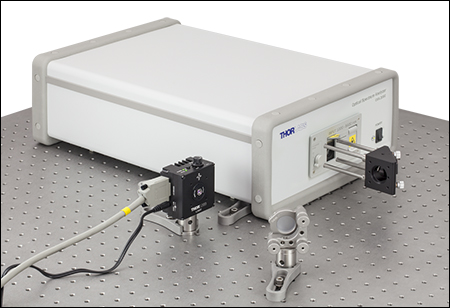
Click to Enlarge
SOFTWARE
Software
Version 3.36
This version includes a GUI for controlling the OSA20xC and Redstone® OSA30x, as well as a "virtual device" mode ideal for evaluating the software prior to purchase.
ThorSpectra Software for the Optical Spectrum Analyzers
Each Optical Spectrum Analyzer includes a Windows® laptop with our OSA software suite pre-installed. This software features a straightforward, intuitive, responsive interface that exposes all functions in one or two clicks. We regularly update this software to add significant new features and make improvements suggested by our users. Several key functions are explained in the Tutorial Videos tab.
The software download page also offers programming reference notes for interfacing with our instruments using LabVIEW®, Visual C++, and Visual C#.
Version 3.20 and higher can be used to control all OSA20xC, Redstone OSA30x, and CCS series devices. The software can export data into various file formats, including Matlab, Galactic SPC, JCAMP-DX, CSV, and text formats.
Software Highlights
The text below summarizes several key features of the OSA software suite. Complete details on the software are available in the ThorSpectra User Guide.
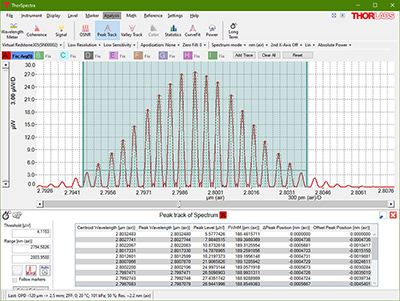
Click to Enlarge
Figure 5.1 Peak Track Mode Used with a 2.8 µm Fabry-Perot Laser
Built-In Tools for Simple and Complex Analysis
The OSA software displays either the fast-Fourier-transformed spectrum or the raw interferogram obtained by the instrument. In the main window, it is possible to average multiple spectra or interferograms; display the X-axis in units of nm (in air or vacuum), cm-1, cm-1 (Raman Shift Wavenumber), THz, or eV; compare the live spectrum to previously saved traces; perform algebraic manipulations on data; and calculate common quantities such as transmittance and absorbance.
Robust graph manipulation tools include automatic and manual scaling of the displayed portion of the trace and markers for determining exact data values and visualizing data boundaries. Automated peak and valley tracking tools (see Figure 5.1) identify up to 2048 peaks or valleys within a user-defined wavelength range and follow them over a long period of time. Statistical parameters of traces such as standard deviations, RMS values, and weighted averages are available, and a curve fit tool fits polynomials, Gaussians, and Lorentzians to the spectrum or interferogram.
Acquired data can be saved as a spectrum file that can be loaded quickly into the main window. Data can also be exported into Matlab, Galactic SPC, JCAMP-DX, CSV, and text formats.
Adjustable Sensitivity and Resolution Settings
The scan sensitivity and resolution can be adjusted by the user to balance the needs of the experiment against the data acquisition rate. These settings vary the number of data points per interferogram from 50 thousand to 16 million. The sensitivity setting modifies the range of detector gain levels, while the resolution setting controls the optical path difference (OPD). The table in the Specs tab shows how the data acquisition rate depends upon the chosen settings.
Wavelength Meter Tool for Narrowband Sources
For sources with <10 GHz linewidth, the Wavelength Meter tool enables extremely accurate determinations of the center wavelength (±1 ppm accuracy, 0.2 ppm precision, and 0.1 ppm resolution). This mode allows the system to resolve a fraction of a fringe in the interferogram, using the internal stabilized reference laser (see Interferogram Data Acquisition in the Design tab for details). The uncertainty in the measurement is continuously determined and displayed as gray numbers.
As shown in Figure 5.1, a built-in tool plots the output of the wavelength meter measurement as a function of time. If the software determines that the wavelength meter will give inaccurate results (as it would for broadband sources), it is automatically disabled.
Coherence Length Module for Broadband Sources
Because Thorlabs' OSAs obtain the raw interferogram of the unknown source (as opposed to grating-based spectrum analyzers, which cannot offer this capability), the software is able to calculate the coherence length of the input signal, as shown in Figure 5.2. The Coherence Length tool considers the envelope of the interferogram and reports the optical path length over which the envelope's amplitude decays to 1/e of its maximum value on both sides.
The ability to view the interferogram in real time allows the user to confirm the coherence length reported by the software and adjust the signal amplitude to avoid saturation. The maximum coherence length measurable by the OSA is limited by the maximum optical path difference in the highest-resolution setting, making this tool best suited for broadband sources.
Apodization and Interferogram Truncation
Since the resolution of any Fourier-transformed spectrum is intrinsically constrained by the finite path length over which the interferogram is measured, the software implements several functions to account for the effect of the finite path length on the spectrum that is obtained. The user may select from a number of apodization methods (dampening functions), including cosine, triangular, Blackman-Harris, Gaussian, Hamming, Hann, and Norton-Beer functions. Furthermore, the effective optical path length can also be shortened to eliminate contributions from high-frequency spectral components.
Libraries for LabVIEW, C, C++, C#, and Python
Device interface libraries containing a multitude of routines for data acquisition, instrument control, and spectral processing and manipulation are also provided with the instrument. These libraries can be used to develop customized software using LabVIEW, C, C++, C#, Python, or other programming languages. We also provide Python SDK and a set of LabVIEW routines to assist with writing your own applications.
Spectroscopic Analysis from HITRAN Reference Database
In environmental sensing and telecom applications, it is often useful to identify atmospheric compounds (such as water vapor, carbon dioxide, and acetylene) whose absorption lines overlap with that of the source being measured. Some example measurements are shown in Figures 5.3 and 5.4. The OSA software includes built-in support for HITRAN line-by-line references, which can be used to calculate absorption cross sections as a function of vapor pressure and temperature. The predictions can be fit to the measured trace for comparison, and fits using mixtures of gases are supported. See the Gas Spectroscopy tab for an example setup.
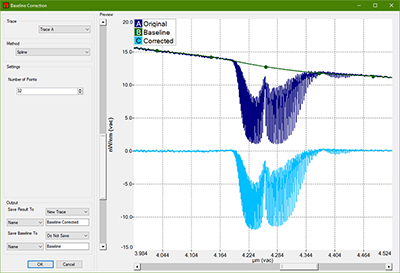
Click to Enlarge
Figure 5.4 Carbon Dioxide Absorption Before and After Baseline Correction
TUTORIAL VIDEOS
Software Tutorial Videos
To help customers learn about, use, and understand the Optical Spectrum Analyzer software, we have prepared several short narrated videos that describe the basic aspects of the software and the optimal settings for common types of measurements. Although the OSA model shown in the videos has been discontinued, the principles of operation have not changed.
Basic Features of OSA SoftwareTopics Covered
Length: 4:41 |
Tips for Choosing the Best Acquisition SettingsTopics Covered
Length: 3:54 |
Measuring a Narrowband SourceTopics Covered
Length: 3:13 |
Measuring Optical Input PowerTopics Covered
Length: 1:24 |
Performing a Filter MeasurementTopics Covered
Length: 2:38 |
SHIPPING LIST
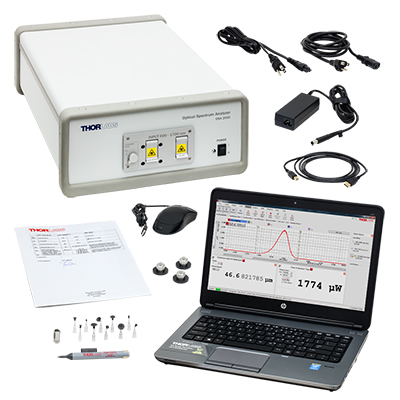
Click to Enlarge
Figure 7.1 OSA202C Contents (North American Power Cords Shown)
Shipping List
Every OSA20xC order includes the following:
- Optical Spectrum Analyzer
- Windows® Laptop
- Includes Pre-Installed OSA Software and a Mouse
- U.S. English Configuration
- Factory Calibration Report
- OSA and Laptop Power Supplies with Region-Specific Power Cords
- High-Speed USB 2.0 Cable (Replacement Item # USB-A-79)
- Connects the OSA to the Laptop
- Three Mounting Feet
- Used to Secure the Interferometer to an Optical Table (See Free-Space Coupling Tab)
- SPW603 Spanner Wrench and VP10C Vacuum Pickup Tool
- Used to Remove Protective Window in Front of Free-Space Input in Cases When
Etalons are Visible in the Spectrum
- Used to Remove Protective Window in Front of Free-Space Input in Cases When
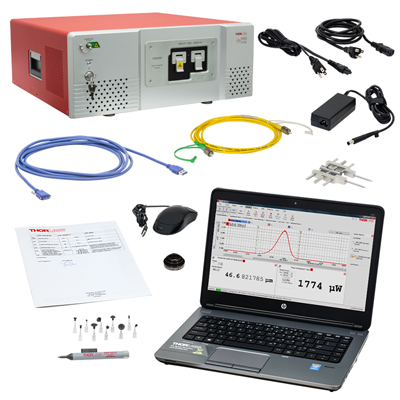
Click to Enlarge
Figure 7.2 Redstone OSA305 Contents (North American Power Cords Shown)
Every Redstone® OSA30x order includes the following:
- Optical Spectrum Analyzer
- Windows® Laptop
- Includes Pre-Installed OSA Software and a Mouse
- U.S. English Configuration
- Factory Calibration Report
- OSA and Laptop Power Supplies with Region-Specific Power Cords
- USB 3.0 Cable (Replacement Item # CABU31)
- Connects the OSA to the Laptop
- SPW801 Spanner Wrench and VP10C Vacuum Pickup Tool
- Used to Remove Protective Window in Front of Free-Space Input in Cases When
Etalons are Visible in the Spectrum
- Used to Remove Protective Window in Front of Free-Space Input in Cases When
- Lens Tube Adapter for Free-Space Port
- Calibration Patch Cable (Replacement Item # P5-SMF28E-FC-2)
PULSED SOURCES
Analyzing Pulsed Sources Using the OSA20xC and Redstone® Instruments
Introduction and Summary of Results
While Thorlabs' Optical Spectrum Analyzers (OSAs) have been designed for analysis of CW signals, it is possible to measure pulsed spectra under certain situations. Measurement of pulsed spectra suffers from several issues that must be overcome for accurate measurements; for instance, "spectral ghosts" arise due to the pulsed nature of the source as well as the varying optical path difference (OPD) of the OSA. In addition, the noise floor for pulsed sources is much higher than that for CW sources. One method for measuring pulsed sources with the OSA involves taking several successive measurements at the different sensitivity levels; the minimum at each wavelength of these traces is used to form a combined spectrum, which suppresses the spectral ghosts. This technique is implemented in the OSA software by choosing "Pulsed" under the "Sweep" or "Instrument" menu. The following tutorial explains the rationale of this technique and the pulsed sources for which it is useful.
In summary, for pulse rates over 30 kHz for the OSA20xC and 6 kHz for the OSA30x, standard measurements can be performed because the repetition rate is greater than the detectors' bandwidth. For broadband signals with low repetition rates, care must be taken to ensure that the "zero burst" of the interferogram coincides with one of the pulses. Also, when using a pulsed source "Automatic Gain" does not work properly, so the user must monitor the interferogram and manually set the gain and offset so that a strong, but not saturated, signal is obtained. For more information on using a pulsed source with our OSA instruments, please contact Tech Support.
Impact of a Pulsed Source on the Interferogram and Spectrum
As the Optical Path Difference (OPD) continuously changes during an interferogram measurement, a pulsed light source effectively modulates the interferogram. In the case of 100% modulation (i.e. on-off pulsation), the resulting interferogram will contain repetitive regions (slots) with no information. These slots correspond to OPDs when no light can be measured by the detector assembly. The resulting interferogram in this case is the true interferogram masked with the pulsed signal. Figure 8.1 shows measured interferograms and the corresponding spectra for a light source in CW and pulsed operation. Although the spectrum of the light source is expected to be the same for CW and pulsed operation (ignoring small changes in the peak shape and position due to, for example, a decreased LD chip temperature resulting from the pulsed drive), additional frequency artifacts appear symmetrically about the expected peak due to the modulation in the pulsed interferogram. These "spectral ghosts" are a result of the temporal, rather than the spectral, behavior of the source. To measure the true spectrum of the light source, it is crucial to make the spectral ghosts sufficiently small or force the spectral ghosts to fall outside the frequency / wavelength range of interest.
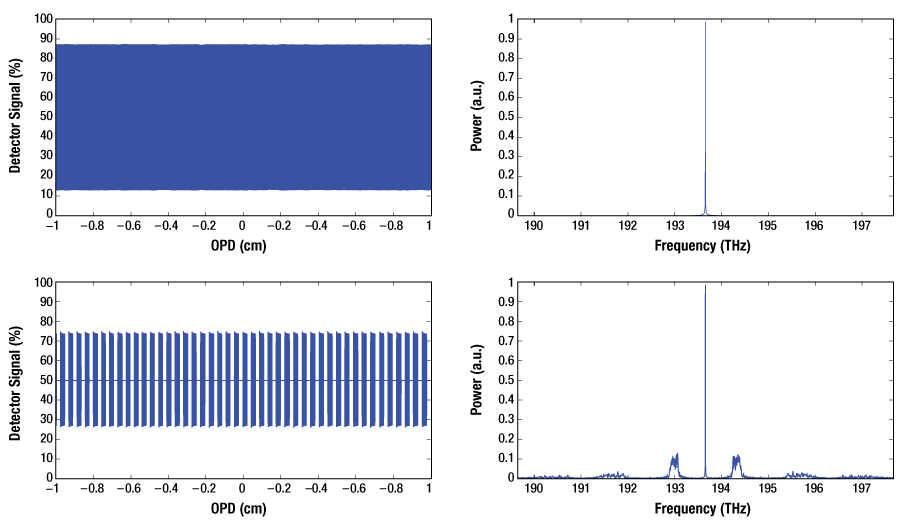
Figure 8.1 Interferograms and spectra for a narrowband light source in CW (Top) and pulsed at 20 kHz (Bottom)
operation measured with an OSA20xC device. The square wave modulation of the interferogram induces the spectral ghosts shown in the bottom right plot.
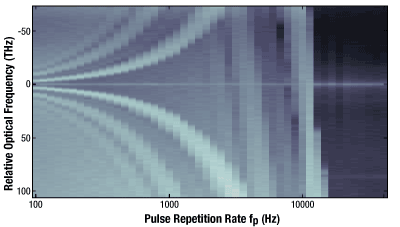
Click to Enlarge
Figure 8.2 Stacked spectra for 55 pulse repetition rates between 100 Hz and 100 kHz for a 1550 nm DFB laser diode measured with an OSA20xC device. The intensity is mapped in a logarithmic scale. OSA settings: High Resolution, High Sensitivity, No Apodization, 5 averages.
Mathematically, the resultant spectrum of a pulsed source can be described by a convolution between the spectrum of the light source and the spectrum corresponding to the pulses. As a result, the impact of these artifacts will vary with the pulse repetition rate and the modulation depth of the light source as well as the OPD sample rate (cm/s) of the OSA. The modulation depth of the light source determines the amplitude of the spectral ghosts; a weak modulation yields weak spectral ghosts while a modulation of 100% (on-off pulsation) yields the strongest spectral ghosts.
Figure 8.2 shows how the behavior of the spectral ghosts as a function of the pulse repetition rate for a narrowband source. In Figure 8.2, the spectra were measured for 55 pulse repetition rates between 100 Hz and 100 kHz for a 1550 nm DFB laser diode connected to an OSA20xC device. We have offset the y-axis such that the true peak (the light gray horizontal line) has been centered at a relative frequency of 0 THz. Figure 8.2 can be divided into three regions: fp ≤ 3 kHz, 3 kHz < fp ≤ 30 kHz and fp >30 kHz. For fp ≤ 3 kHz, the spectral ghosts are clearly observed symmetrically about the true peak within the resultant spectrum, and move farther and farther away from the true peak as the repetition rate increases. The second region starts above 3 kHz, when the first spectral ghosts have moved beyond the spectral range of the OSA. However, aliasing / folding create higher order spectral ghosts that appear within the spectral range of the OSA. In the third region, fp > 30 kHz, the resulting spectrum agrees very well with the CW spectrum because the repetition rate of the source has extended beyond the bandwidth limit of the detectors. As a result, the pulsed source appears like a CW source to the OSA electronics.
"Pulsed Mode" Operation
To help remove some of these frequency artifacts, the OSA software contains a "Pulsed Mode" measurement (Figure 8.3). The "slot period" of the interferogram, determined by the pulse repetition rate of the light source and the OPD rate of the OSA, affects the positions of the spectral ghosts. A shorter slot period yields a larger spectral distance between the true peak and the first order ghost peaks. In Thorlabs' OSAs, the OPD sample rate is given by the speed of the moving carriage which can be controlled by the user indirectly through the sensitivity setting. The higher the sensitivity setting is, the slower the speed of the moving carriage will be. Thus, the use of the "High" sensitivity mode of the OSA will provide the shortest slot period (i.e. the largest spacing between the feature of interest and the frequency artifacts). In Pulsed Mode, the software acquires several spectra with different sensitivity settings (or OPD sample rates) and filters out the changing spectral features. The sensitivity is set to increasingly high levels, starting with Low. After reaching the highest sensitivity, it is again set to Low, yielding a periodically changing sensitivity. The captured spectra are then combined using the minimum hold function. The spectral ghosts (Figure 8.4), whose positions depend on the sensitivity setting (the OPD rate), can then be reduced in the measurement as shown in Figure 8.4. It is important to note that the Pulse Mode button is found under the "Sweep" or "Instrument" menu and can be started only after the current sweep has been completely stopped.
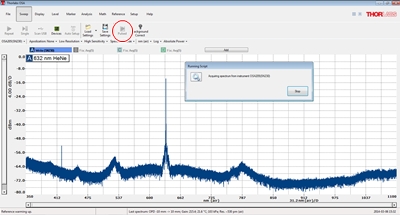
Click to Enlarge
Figure 8.3 Screenshot of the OSA software in Pulsed
Mode; the icon is indicated with a red circle.
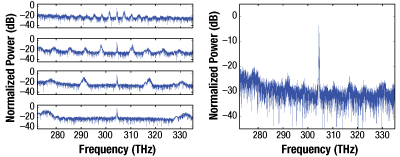
Click to Enlarge
Figure 8.4 (Left) Measured spectra for a narrowband light source pulsed at 1 kHz with (from top to bottom) Low, Medium-Low, Medium-High, and High sensitivity settings (i.e. a decreasing OPD sample rate from top to bottom). (Right) Measured spectrum using the Pulsed Mode, i.e., a minimum hold combination of spectra similar to those shown in the bottom left plots.
Narrowband Light Source
A DFB laser diode emitting at 1550 nm (193.7 THz) was used as a narrowband light source and measured with an OSA203C in both CW and pulsed operation. The laser diode was modulated (using Thorlabs' ITC4001 controller) with repetition rates between fp = 20 Hz and 100 kHz. Five averaged spectra were captured for each light source setting; the CW spectra were acquired in high sensitivity mode, and the pulsed spectra were recorded in both high sensitivity and pulsed mode. It is important to note that the pulsed mode does not allow averaging. Instead the minimum hold function was used for 5 sets of spectra from the four different sensitivity settings.
Figure 8.5 shows the resultant spectra for the source in CW mode as well as four different pulse repetition rates between 100 Hz and 100 kHz. As the pulse rate increases, the spectral ghosts (as recorded in the high sensitivity mode) move further and further away from the true laser peak until nearly identical spectra are obtained at 100 kHz.
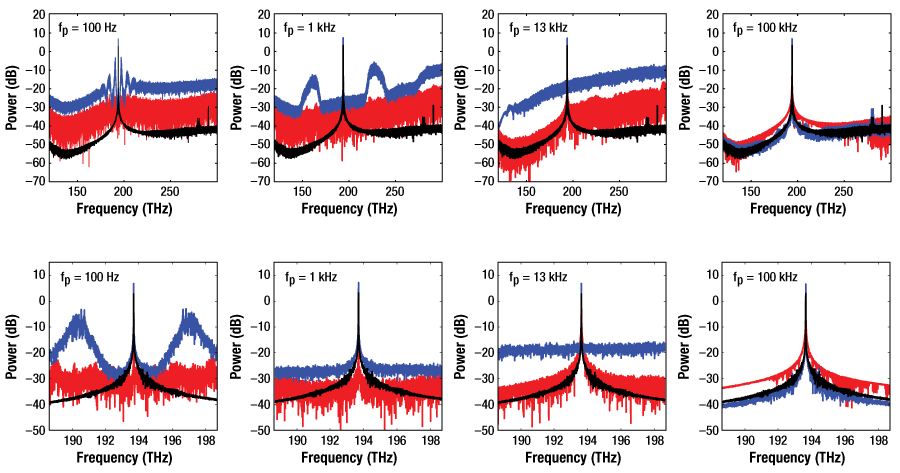
Figure 8.5 Spectra from measurements of a 1550 nm (193.7 THz) pulsed narrowband source. Pulse repetition rates shown (left to right): 100 Hz, 1 kHz, 13 kHz, and 100 kHz. Black line: CW measurement; blue line: pulsed source measured with high sensitivity; red line: pulsed source measured using the pulsed mode. The lower plots are the same data set as the upper plots only on a shorter frequency scale.
Broadband Light Source
A gain chip was driven in amplified spontaneous emission (ASE) mode to create a broadband light source centered at 850 nm (352.9 THz) with a FWHM of 36.4 nm (15.2 THz). An OSA201C was used to measure the spectrum for CW and pulsed operation with pulse repetition rates from fp = 100 Hz to 100 kHz. The ASE diode was modulated (using Thorlabs' ITC4001 controller) with a 50% duty cycle square wave. A total of 10 averaged spectra were acquired using high sensitivity (CW and pulsed sources) and the pulsed mode (pulsed source). Because pulsed mode does not allow averaging, the minimum hold function was used to acquire five sets of the four different sensitivity settings.
In general, the spectral ghosts are less visible for the broadband peak compared to a narrowband peak. However, the noise floor is higher and the spectral ghosts are clearly seen for a repetition rate of 1 kHz and 13 kHz in Figure 8.6. Similar to the narrowband source, the spectral ghosts move farther and farther away from the true peak with increasing repetition rate. For a repetition rate of 100 kHz both the measurement using high sensitivity and pulsed mode agree well with the CW measurement. As seen, the shape of the peak is slightly different for the CW spectrum compared to the pulsed spectrum. This is not related to the behavior of the OSA but due to a true change in the peak during pulsed operation, e.g., a lower chip temperature.
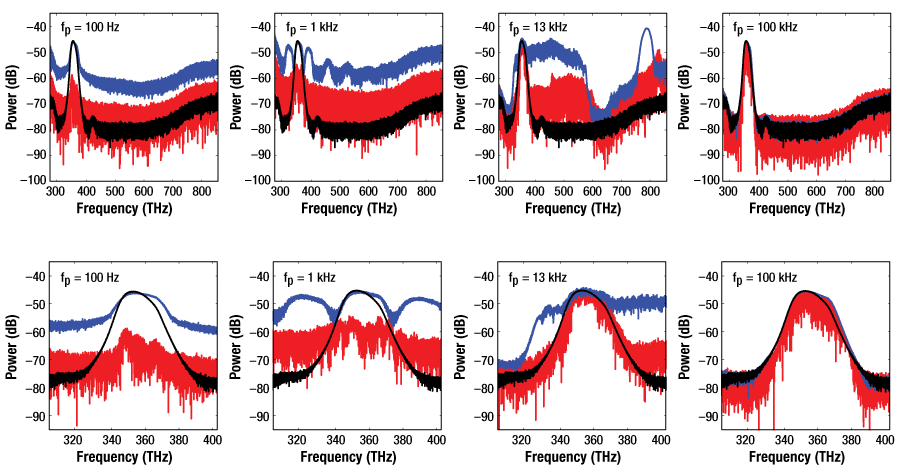
Figure 8.6 Measured spectra from a pulsed broadband source with a center wavelength (frequency) of 850 nm (352.9 THz). The pulse repetition rates shown are 100 Hz, 1 kHz, 13 kHz, and 100 kHz. Top and bottom rows show the full spectrum and the ±50 THz range surrounding the peak, respectively. Black line: CW; blue line: pulsed source measured using high sensitivity; red line: Pulsed Mode.
It is extremely important to note that in general, one has to be careful when measuring broadband peaks at low repetition rates. Since most of the information in the interferogram is located about the zero burst, the peak can be completely missed if the zero burst coincides with no light falling on the detector as shown in Figure 8.7.

Figure 8.7 Measured interferograms (left) and spectra (right) obtained when the zero burst resulting from a broadband
source coincides with a pulse (blue curves) and is missed if no light reaches the detector at OPD ~ 0 (red curves).
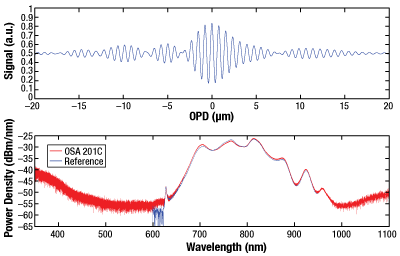
Click to Enlarge
Figure 8.8 (Top) Central portion of a captured interferogram from a broadband femtosecond laser. (Bottom) Measured spectrum captured using an OSA201 (red line) and a measured reference spectrum captured using a scanning grating-based OSA (blue line).
Femtosecond Pulsed Laser
We measured the spectrum of a broadband femtosecond laser using an OSA201C. This laser has a repetition rate of 85 MHz, a pulse width of 10 fs, and an average power of about 300 µW into the fiber. The OSA was set to Low Resolution, High Sensitivity, 5 spectral averages, and no apodization. Light output from the laser was collected with a fiber patch cable (SM600 fiber; 0.12 NA, 4.6 µm mode field diameter at 680 nm) connected to the OSA.
Figure 8.8 shows the interferogram collected during acquisition, which does not contain any empty slots. This was expected as the 85 MHz repetition rate of the laser is well beyond the 40 kHz bandwidth of the OSA's detectors. Furthermore, the spectrum measured by the OSA agrees very well with the reference spectrum captured using a grating-based OSA that is scanned slowly enough to provide adequate signal for each wavelength measured.
GAS SPECTROSCOPY
| Table 9.3 OSA Detection Ranges | ||
|---|---|---|
| Item # | Frequency Range | Level Sensitivity (Click for Graph)a |
| OSA207C | 833 - 10 000 cm-1 (12.0 - 1.0 µm) |
Absolute Power Power Density |
| OSA205C | 1786 - 10 000 cm-1 (5.6 - 1.0 µm) |
|
| OSA305 | ||
| OSA203C | 3846 - 10 000 cm-1 (2.6 - 1.0 µm) |
|
| OSA302 | 4000 - 40 000 cm-1 (2.5 µm - 250 nm) |
|
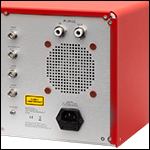
Click to Enlarge
Figure 9.2 Rear-Mounted Hose Connections for Purging the Redstone® OSA30x Cavity
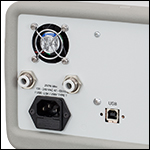
Click to Enlarge
Figure 9.1 Hose Connections for Purging OSA20xC Cavity
Gas Detection and Identification Using an Optical Spectrum Analyzer
As shown in Table 9.3, many of Thorlabs' Optical Spectrum Analyzers (OSAs) offer detection extending into the mid-infrared (MIR) region of the spectrum, where many gaseous species characteristically absorb. Moreover, the software included with all OSA models supports files from the HITRAN database, a spectroscopic reference standard. These files can be fit to measured traces to identify unknown gases. With the ability to fit multiple analytes simultaneously and built-in hose connections (compatible with Thorlabs' Pure Air Circulator Unit) for purging the interferometer's cavity of trace gases, these OSAs are ideal for use in home-built gas detection setups.
Experimental Setup
A sample detection setup is shown in Figure 9.4. Broadband MIR light generated by a Stabilized Light Source is emitted from a zirconium fluoride fiber ( ), collimated, then sent into a multipass cell (
), collimated, then sent into a multipass cell ( ) containing the gas analyte in a sample chamber. Each end of the chamber is sealed by an airtight, transparent window. Gold mirrors on each side of the chamber provide multiple reflections that increase the sensitivity of the measurement; the mirror closer to the light source has a center hole to allow the optical path to enter and exit the chamber. Light exiting the detection setup is collimated by a long-focal-length lens and reflected by a D-shaped mirror into the free-space port of the OSA203C (
) containing the gas analyte in a sample chamber. Each end of the chamber is sealed by an airtight, transparent window. Gold mirrors on each side of the chamber provide multiple reflections that increase the sensitivity of the measurement; the mirror closer to the light source has a center hole to allow the optical path to enter and exit the chamber. Light exiting the detection setup is collimated by a long-focal-length lens and reflected by a D-shaped mirror into the free-space port of the OSA203C ( ). The temperature inside the chamber is elevated and held constant in order to prevent the gas's absorption lines from shifting during the measurement.
). The temperature inside the chamber is elevated and held constant in order to prevent the gas's absorption lines from shifting during the measurement.
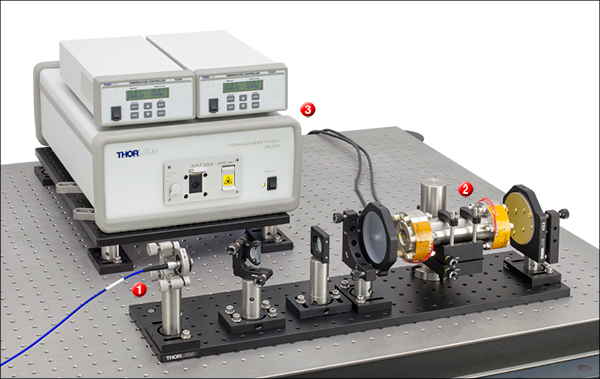
Click to Enlarge
Figure 9.4 A gas detection setup using the OSA203C. A multipass cell is constructed around the sample chamber (
 ) in order to provide high detection sensitivity for the gaseous species sealed inside.
) in order to provide high detection sensitivity for the gaseous species sealed inside.| Parts Used in Sample Setup (Click Here for a Metric Item List) |
||
|---|---|---|
| Item # | Qty. | Description |
Light Source  |
||
| SLS202La | 1 | Stabilized Fiber-Coupled Light Source, 450 nm - 5.5 µm (Not Shown) |
| FB2000-500 | 1 | Ø1" Bandpass Filter, 2.0 µm CWL, 0.5 µm FWHM (Not Shown) |
| MZ21L1 | 1 | ZrF4 Multimode Fiber Patch Cable, SMA905 Connectors |
| F028SMA-2000 | 1 | SMA905 Fiber Collimator, AR Coated: 1.8 - 3.0 µm |
| POLARIS-K1b | 1 | Polaris® Ø1" Kinematic Mirror Mount |
| AD11NT | 1 | Unthreaded Adapter for Ø11 mm Cylindrical Components |
Detection  |
||
| OSA203C | 1 | Optical Spectrum Analyzer, 1.0 - 2.6 µm |
| TC200c | 2 | Temperature Controller |
| MB1218 | 1 | 12" x 18" Aluminum Breadboard |
| CF125C | 3 | Clamping Fork with Captive Screw |
| Other Optomechanics | ||
| RS2 | 6 | Ø1" Pillar Post, Length = 2" |
| RS3 | 1 | Ø1" Pillar Post, Length = 3" |
| RS4 | 2 | Ø1" Pillar Post, Length = 4" |
| BA2F | 9 | Flexure Clamping Base |
| Parts Used in Sample Setup (Continued) (Click Here for a Metric Item List) |
||
|---|---|---|
| Item # | Qty. | Description |
Beam Path Into and Out of Multipass Cell  |
||
| LB4374 | 1 | Uncoated, Ø1", f = 1000 mm Bi-Convex UV Fused Silica Lens |
| CP33 | 1 | Post-Mountable, SM1-Threaded Cage Plate for Ø1" Optics |
| CM750-200-M01 | 2 | Ø75 mm, f = 200 mm Protected Gold Concave Mirror (One Mirror Contains a Center Hole, Similar to Our Herriott Cell Mirrors) |
| KS3 | 2 | Kinematic Mount for Ø3" Mirrors |
| VPCH512 | 2 | Ø2.75" CF Flange with CaF2 Window, 180 nm - 8.0 µm |
| N/A | 1 | Sample Chamber |
| C1513 | 1 | Kinematic V-Clamp Mount |
| PM4 | 2 | Clamping Arm (One Clamping Arm is Included with Each C1513 Mount) |
| P6 | 1 | Ø1.5" Mounting Post, Length = 6" |
| PB2 | 1 | Base for Ø1.5" Mounting Posts |
| PFD10-03-M01 | 1 | 1" Protected Gold D-Shaped Pickoff Mirror |
| KM100D | 1 | Kinematic Mount for 1" D-Shaped Pickoff Mirrors |
| MB624 | 1 | 6" x 24" Aluminum Breadboard |
Assigning Peaks in an Unknown Spectrum
Once the experimental spectrum is obtained, the user chooses a gas or gas mixture that is believed to be present inside the sample chamber, as shown in Figure 9.5. There is no limit to how many species can be considered in the fit, but the fit is more likely to converge when fewer species are chosen. The OSA software ships with HITRAN line-by-line references for acetylene (C2H2), water vapor (H2O), and carbon dioxide (CO2), and can import additional references downloaded from the HITRAN database. Previously saved spectra in the OSA file format can also be used as references. See the References section of the ThorSpectra manual for details.
The user may optionally allow the software to shift the reference spectrum in wavelength in order to account for measurement effects related to the sample environment. In the case of gas mixtures (i.e., fits performed using more than one reference spectrum), the software scales the intensity of each reference as needed to reproduce the measured spectrum. As shown in Figure 9.6, the output of the fit operation is a graph comparing the measured spectrum, each scaled (and possibly also shifted) reference spectrum, and the sum of the scaled reference spectra.
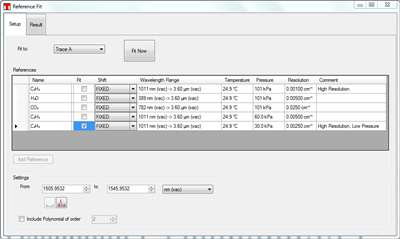
Click to Enlarge
Figure 9.5 In the Reference Fit Setup tab, checkboxes are used to indicate which gaseous species to consider in the fit. The absorption lines can be either "fixed" or "free"; the latter allows the software to shift the reference spectrum in wavelength. The measurement conditions for the HITRAN references are also displayed.
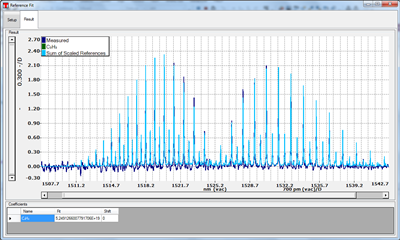
Click to Enlarge
Figure 9.6 In the Reference Fit Result tab, the fitted spectrum is displayed simultaneously with the measured spectrum. The fitted spectrum is the sum of the scaled reference spectra included in the fit. The scaled spectrum for each individual gaseous species is also shown.
PIC TESTING DEMO
PIC Demo Testing Station
Thorlabs offers a variety of components that enable construction of a photonic integrated circuit (PIC) testing station, including imaging systems, fiber optics, precision piezos, and manual stages. This page presents a demo system that drives an on-chip laser and collects and analyzes the emitted light. The laser chip employed in this example PIC testing setup is a fully integrated, heterogeneous GaAs-on-SiN platform with an array of tunable lasers, with each source capable of coarsely covering the range from 765 to 795 nm. This PIC chip was supplied by Nexus Photonics. The scheme of this PIC testing demo can be generalized and customized to meet the needs of testing various PIC chips and is not restricted to the specific circuit used here. Click on the highlighted areas in Figure 787B or the links in Table 787A to find descriptions of the subsystems that comprise the demo testing station. Tables 787C and 787D provide a comprehensive list of all parts used in the demo.
| Table 787A PIC Demo Subsystems | |||||
|---|---|---|---|---|---|
| Imaging | Light Collection | PIC Control and Readout | PIC Chip Stage | Probe Card Positioning | General Setup |
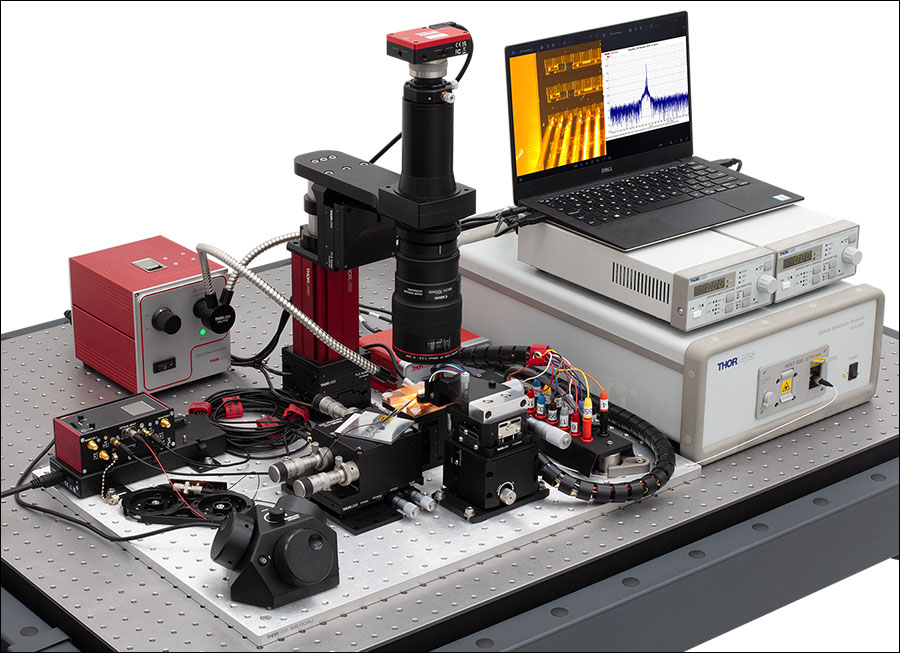
Figure 787B PIC Testing Demo Setup
| Table 787C PIC Demo Parts List | ||
|---|---|---|
| Item #a | Qty. | Description |
| N/A | 1 | PIC Chip (Supplied by Nexus Photonics) |
| Imaging | ||
| SFM2b | 1 | Cerna® Mini Microscope |
| MCM301 | 1 | Three-Channel Stepper Motor Controller for Cerna Components |
| MCMK3 | 1 | 3-Knob USB HID Joystick |
| PLSXY | 1 | 2D Motorized Translation Stage for Rigid Stands |
| PLSZ | 1 | Motorized Module with 1" Travel, 95 mm Dovetail |
| LP126CU(/M) | 1 | Kiralux® Low-Profile 12.3 MP Color CMOS Camera |
| SM2CEFM | 1 | Adapter with External SM2 Threads and Female EF-Mounting Ring |
| CXY1A | 1 | XY Translating Lens Mount for Ø1" Optics |
| N/A | 1 | Canon Macro Lens |
| OSL2 | 1 | High-Intensity Fiber-Coupled Illuminator with Fiber Bundle |
| OSL2YFB | 1 | Gooseneck Y-Bundle for OSL2 and OSL2IR Fiber Light Sources |
| Light Collection | ||
| LFM1F-1 | 1 | FC/PC to Lensed Tip Fiber Patch Cable, Ø50 µm, 0.20 NA |
| TM50R2F1B | 1 | 1x2 Multimode Fiber Optic Coupler, Low OH, Ø50 µm Core, 0.22 NA, 90:10 Split, FC/PC |
| ADAFC3 | 2 | FC/APC to FC/APC Mating Sleeve |
| MAX311D(/M) | 1 | 3-Axis NanoMax™ Stage, Differential Drives, Closed-Loop Piezos |
| PY004(/M) | 1 | High-Load Pitch and Yaw Platform |
| KNA-VIS | 1 | K-Cube® NanoTrak® Active Auto-Alignment Controller, 320 - 1000 nm |
| KPC101 | 1 | K-Cube Piezo Controller and Strain Gauge Reader (Not Shown) |
| KEH3 | 1 | Controller Hub and Power Supply for Three K-Cubes or T-Cubes |
| Table 787D PIC Demo Parts List (Continued) | ||
|---|---|---|
| Item #a | Qty. | Description |
| PIC Control and Readout | ||
| LDC202C | 2 | Benchtop LD Current Controller, ±200 mA HV |
| OSA202C | 1 | Fourier Transform Optical Spectrum Analyzer |
| PIC Chip Stage | ||
| MVS05(/M) | 1 | 1/2" Travel Vertical Translation Stage |
| N/A | 1 | Custom Machined Copper Mount for Chip Stage |
| Probe Card Positioning | ||
| XRV1(/M) | 1 | 14.0 mm Travel Vertical Translation Stage |
| LX20(/M) | 1 | Self-Contained XY 25 mm Translation Stage |
| N/A | 1 | Signatone Probe Card Holder |
| N/A | 1 | Custom Machined Probe Card Adapter |
| General Setup, Organization, and Cable Management | ||
| MB1824Ub | 1 | 18" x 24" Unanodized Aluminum Breadboard |
| CMS015 | 1 | Slit Harness Wrap, 5 m (16.5 ft) |
| BFCT | 1 | Passive Component Fiber Tray |
| CSV4 | 1 | Hook-and-Loop-Fastener Cable Straps with Lockdown Rivet (Qty. 5) |
| CS1 | 1 | Screw-On Cable Straps (Qty. 15) |
| B3648FXc | 1 | 36" x 48" Optical Breadboard |
| SDA90120 | 1 | ScienceDesk Frame for 36" x 48" (900 mm x 1200 mm) Tabletops |
Imaging
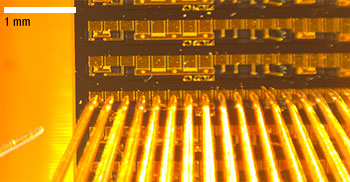
Click to Enlarge
Figure 787E Image of PIC chip, probes, and collection fiber acquired by the imaging system. The lensed fiber used for light collection can be seen in the lower left of the image. The scale bar shows 1 mm.
A widefield imaging systema is necessary to facilitate alignment of the probe card and light collection (lensed fiber) systems relative to the the PIC chip. Thorlabs' SFM2 Cerna® Mini Microscope provides a simple means to construct an imaging systemb. An LP126CU Kiralux® Scientific Camera attached to the SFM2 Mini Microscope displays the image of the PIC chip, probe card, and collection fiber (shown in Figure 787E). Illumination from a light source like the OSL2 High-Intensity Fiber-Coupled Illuminator can be guided to the chip via the OSL2YFB gooseneck fiber bundle. The combination of an MCM301 Stepper Motor Controller and an MCMK3 USB Joystick with the PLSXY and PLSZ Motorized Translation Stages enables three-dimensional motorized control of the imaging system.
- In this context widefield means an imaging field comparable to the size of the PIC chip.
- An EF-Mount Adapter Ring such as the SM2CEFM can be used to connect the camera lens to the Cerna microscope.

Click to Enlarge
Figure 787F PIC Chip Close Up Showing Probe Card, Collection Fiber, Illumination, and Imaging Microscope
Light Collection
Figure 787F shows a close up of the light collection geometry. Light emitted from the chip is collected by an LFM1F-1 Lensed Multimode Fiber and coupled into an optical spectrum analyzer (as discussed in the previous section). If multiple facets of analysis are desired, the signal can be split using a multimode fiber optic coupler such as the TM50R2F1B. To achieve adequate signal-to-noise ratio, fine positional control of the collection fiber is necessary. Thorlabs offers many components enabling precision control of fiber optics. Thorlabs' NanoMax™ line provides precision fiber positioning, and a PY004 base allows pitch and yaw control. The NanoMax MAX311D contains piezos, which can be controlled for auto-alignment with a combination of the KNA-VIS and KPC101 K-Cube® Controllers. The KEH3 and KEH6 K-Cube controller hubs provide power, Ethernet, and USB connectivity for the K-Cubes.

Click to Enlarge
Figure 787G Screenshot of Spectrum Acquired with the OSA202C
PIC Control and Readout
In order to drive the laser circuit on the chip, current is supplied to the PIC chip via the probe card. Two LDC202C Laser Diode Drivers serve as the current sources here. Emitted light collected from the chip is directed into the fiber-coupled OSA202C Optical Spectrum Analyzer, which provides analysis and display of the signal. Figure 787G shows an example screenshot of the spectrum acquired by the OSA202C.
Depending on the particular PIC chip/testing application, various beam characterization and polarization measurement instruments can be used to construct a custom analysis setup to meet specific needs. Examples include the CCT10 Compact CMOS Spectrometer for spectroscopy, the PNA1 Intensity Noise Analyzer for high frequency-axis noise analysis, and the PAX1000IR1 Polarimeter for polarization measurements.
 |
 |
 |
 |
 |
| Laser Diode Drivers | Optical Spectrum Analyzers | Compact CMOS Spectrometers | Intensity Noise Analyzer | Polarimeters |
Positioning
PIC Chip Stage
Vertical (Z-axis) control of the PIC chip aids in focusing the widefield imaging system. A vertical drive stage such as the MVS05 Stage provides this additional degree of freedom. If more range is needed, the MVS1 Vertical Translation Stage allows up to 1" of travel.
Probe Card
The probe card serves to supply a multipoint electrical contact directly to the on-chip devices. To achieve optimal/flush contact with the chip multiple degrees of freedom are necessary. A vertical translation stage such as the XRV1 Stage provides vertical translation, and the LX20 Stage allows XY translation.
Thorlabs offers a wide selection of manual stages including linear translation, rotation, and multi-axis stages.
 |
 |
 |
 |
 |
| Optical Tables, Breadboards, and Supports | Solid Aluminum Breadboards | ScienceDesk Workstations | ScienceDesk Shelving | Cable Management |
General Setup, Organization, and Cable Management
Thorlabs offers a wide selection of general components and tools for construction, organization, and management of a PIC testing station. Optical tables, breadboards, and supports provide the foundation of any testing setup. ScienceDesk™ workstations can provide a convenient means to construct a vibration isolated table with a small footprint, and shelving affords convenient options for holding tools, equipment, and instruments. Cable management products for electric and fiber optic cables are also available.
Custom Capabilities
Both the lensed fiber holder and probe card holder were custom made for this specific PIC testing station demo application. Thorlabs offers a wide variety of custom solutions and manufacturing capabilities for various applications. Contact techsales@thorlabs.com for further information.
CUSTOM OSAS
Custom OSA Options
- Optical Input
- FC/PC, FC/APC, or SMA905 Fiber Receptacles
- Permanently Installed Optical Bandpass and Notch Filters Before Interferometer
- Application-Optimized Detectors
- High Sensitivity for Low-Level Signal Detection, Such as in Fluorescence or Raman Measurements
- Wavelength Range and Noise Floor Chosen to Match a Specific Light Source
- Custom Software Modules for Data Analysis
Thorlabs' in-stock OSA models offer a number of detection options for various experimental situations. We invite customers whose needs are not addressed by these models to tailor an OSA to a specific application by working with our engineering and manufacturing team.
In the past, we have built OSAs with user-specified optical inputs, such as FC/APC and SMA905 fiber receptacles, and we have incorporated optical bandpass and notch filters directly into the optical path to reduce light source noise. For customers who use these instruments for sample characterization, our software team has implemented user-designed data analysis modules within the standard OSA software suite.
We have also worked with our customers to choose detector elements targeted at specific light sources and analytes. Figures 11.1 and 11.2 were obtained from custom-built OSAs that were designed for especially high detection sensitivity. Our engineers are well-versed in the tradeoffs between detection bandwidth, sensitivity, and linearity, and can make recommendations based upon the needs of the application and prior customers' experiences. By constraining the OSA's design for a particular use case, additional performance enhancements for that application can be realized.
If you would like to discuss a custom OSA, please contact us with your experimental requirements.
High-Sensitivity OSAs
|
|
|
Fourier Transform Optical Spectrum Analyzers, 7.5 GHz Resolution

- Five Models Optimized for Different Spectral Ranges
- OSA201C: 350 - 1100 nm
- OSA202C: 600 - 1700 nm
- OSA203C: 1.0 - 2.6 µm (10 000 - 3846 cm-1)
- OSA205C: 1.0 - 5.6 µm (10 000 - 1786 cm-1)
- OSA207C: 1.0 - 12.0 µm (10 000 - 833 cm-1)
- Two Optical Input Ports
- FC/PC Fiber-Coupled Input
- Free-Space Input with Four 4-40 Taps for 30 mm Cage System Compatibility
- Built-In Hose Connections for Optional Purging
- Includes Windows® Laptop and Items Shown in Shipping List Tab
- Demo Units Available by Contacting Tech Support
Thorlabs' OSAs measure the optical power of both narrowband and broadband sources as a function of wavelength. The maximum spectral resolution of 7.5 GHz (0.25 cm-1) is set by the maximum optical path length difference of ±4 cm, as explained in the Design tab, while the high spectral accuracy of ±2 ppm (parts per million) is ensured by simultaneously measuring the interferogram of a stabilized 632.9918 nm HeNe laser. For sources with linewidth <10 GHz, the Wavelength Meter mode provides center wavelength measurements with 0.1 ppm resolution and ±1 ppm accuracy.
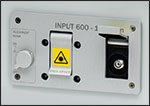
Click to Enlarge
Figure G1.3 FC/PC Fiber Receptacle Behind Door (OSA202C Shown)
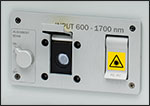
Click to Enlarge
Figure G1.2 Free-Space Optical Input for Ø6 mm Beam Behind Door (OSA202C Shown)
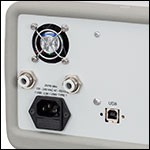
Click to Enlarge
Figure G1.5 Rear-Mounted Hose Connections for Purging on the OSA20xC Instruments
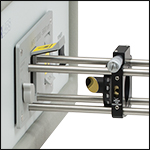
Click for Details
Fiber-Coupled and Free-Space Inputs
All of our OSAs directly accept fiber-coupled or free-space optical inputs. The fiber-coupled input is compatible with single mode and multimode FC/PC patch cables. For multimode patch cables made from standard silica glass, cores up to Ø50 µm and NA up to 0.22 are recommended; for those made from fluoride glass, cores up to Ø100 µm and NA up to 0.26 are recommended. Single mode patch cables provide the highest contrast. OSAs with other fiber input receptacles are available by contacting Tech Support.
The free-space input aperture accepts collimated input beams up to a maximum beam size of Ø6 mm. To align the input light with respect to the OSA's internal interferometer, a red, Class 1 alignment beam, which is activated by a rotating switch, is emitted from the aperture. (See 2:47 in Video G1.1 for a demonstration.) The input beam should be made collinear to the alignment beam for the OSA to provide optimal measurement accuracy. Four 4-40 taps around the input aperture enable compatibility with our 30 mm cage system; use cage rods no shorter than 1.5" to prevent attached cage components from clashing with the door. For more information on free-space coupling, please see the Free-Space Coupling tab.
Hose Inlets for Optional Purging
To reduce the presence of water absorption lines in the measured spectrum, our OSAs offer two 1/4" inner diameter quick-connect hose connections on the back panel, through which the interferometer can be purged with dry air. Thorlabs' Pure Air Circulator Unit is ideal for this task. Purging the OSA is not generally necessary, since none of the optics are made from hygroscopic materials, but can be useful for applications such as gas detection and identification where the presence of trace gases in the housing may affect the measurement. An example setup that uses the OSA203C instrument is described in the Gas Spectroscopy tab.
Software
Each OSA20xC instrument includes a Windows® laptop with our OSA software suite pre-installed and a USB 2.0 cable. This software has a graphical user interface (GUI) that includes a variety of measurement and analysis tools; please see the Software tab for a detailed overview of the software capabilities. To easily interface with the OSAs, a Python SDK and an extensive set of drivers are also available for LabVIEW®, C, C++, and C#.
Part Number | Description | Price | Availability |
|---|---|---|---|
OSA201C | Fourier Transform Optical Spectrum Analyzer, 350 - 1100 nm | $32,920.89 | In Stock Overseas |
OSA202C | Fourier Transform Optical Spectrum Analyzer, 600 - 1700 nm | $32,920.89 | Today |
OSA203C | Fourier Transform Optical Spectrum Analyzer, 1.0 - 2.6 µm | $34,509.73 | Today |
OSA205C | Fourier Transform Optical Spectrum Analyzer, 1.0 - 5.6 µm | $37,369.65 | Today |
OSA207C | Fourier Transform Optical Spectrum Analyzer, 1.0 - 12.0 µm | $42,057.69 | In Stock Overseas |
Fourier Transform Optical Spectrum Analyzers, 1.9 GHz Resolution


Click to Enlarge
Figure G2.2 Rear-Mounted Hose Connections for Purging and BNC Trigger Connections on the Redstone OSA30x
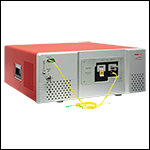
Click to Enlarge
Figure G2.1 The calibration laser can be connected directly to the FC/PC fiber input using the included hybrid patch cable.
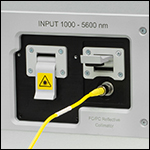
Click to Enlarge
Figure G2.4 FC/PC Fiber Receptacle Behind Door
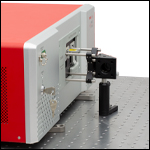
Click to Enlarge
Figure G2.3 60 mm Cage Components can be used to couple a free-space beam into the OSA30x.
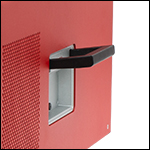
Click to Enlarge
Figure G2.5 The Redstone OSA302 and OSA305 weigh 58.4 lbs (26.5 kg). Handles are included on the side panels for easy lifting.
- Multi-Detector Configuration for Broad Operation Range
- OSA302: 250 nm - 2.5 µm (40 000 - 4000 cm-1)
- OSA305: 1.0 - 5.6 µm (10 000 - 1786 cm-1)
- Four Resolution Settings and Three Sensitivity Levels
- Front Panel Access to Frequency-Locked Laser for Wavelength Calibration
- Two Optical Input Ports
- FC/PC Fiber-Coupled Input
- Free-Space Input with Four 4-40 Taps for 60 mm Cage System Compatibility
- Trigger Input for External Synchronization
- Built-In Hose Connections for Optional Purging
- Includes Windows® Laptop and Items Shown in Shipping List Tab
- Demo Units Available by Contacting Tech Support
Thorlabs' Redstone® OSA302 and OSA305 Optical Spectrum Analyzers (OSA) measure the optical power of both narrowband and broadband sources as a function of wavelength with higher resolution and a lower noise floor compared to the OSAs sold above. The maximum spectral resolution of 1.9 GHz (0.063 cm-1) is set by the maximum optical path length difference of 16 cm, as explained in the Design tab, while the high spectral accuracy reaching down to ±0.2 ppm (parts per million) is ensured by simultaneously measuring the interferogram of a frequency-locked 1532.8323 nm alignment laser. For sources with linewidths <10 GHz, the Wavelength Meter mode provides center wavelength measurements with 0.1 ppm resolution and ±0.5 ppm accuracy.
To meet the needs of your specific application, customization options are available for the Redstone OSAs; please contact Tech Support for assistance. Common specials for this device include alternative input receptacles, small adjustments to the wavelength range, extra test protocols, and shipping without a laptop.
Resolution and Sensitivity
These high-performance OSAs offer four resolution settings that can resolve spectral features 4.0, 1.0, 0.25, or 0.063 cm-1 apart. Three sensitivity levels are also available, which control the acquisition speed and available gain levels. For detailed specifications on the acquisition update frequency for each sensitivity and resolution setting, please see the Specs tab.
Calibration Laser
For the Redstone OSAs, the internal frequency-locked calibration laser is accessible through the FC/APC fiber output located above the power switch on the front panel. This can be used for wavelength calibration by connecting the front-panel output to the FC/PC fiber input using the included single mode patch cable. During calibration, the software compares the measured wavelength to the reference and performs a calibration if necessary.
Interferogram Averaging
An integrated internal broadband reference source allows the Redstone OSAs to accurately determine the location of zero path difference (ZPD) between the two optical branches. The ZPD can be used to average interferograms, which reduces the signal-to-noise ratio. The beam profile overlap between the two branches is optimized using piezoelectric actuators.
Fiber-Coupled and Free-Space Inputs
All of our OSAs directly accept fiber-coupled or free-space optical inputs. The fiber-coupled input is compatible with single mode and multimode FC/PC patch cables. For multimode patch cables made from standard silica glass, cores up to Ø50 µm and NAs up to 0.22 are recommended; for those made from fluoride glass, cores up to Ø100 µm and NAs up to 0.26 are recommended. Single mode patch cables provide the highest contrast. OSAs with other fiber input receptacles are available by contacting Tech Support.
The free-space input aperture accepts collimated input beams with a beam size of up to Ø10 mm, which improves light collection for weak signals as compared to the OSA20xC OSAs. To align the input light with respect to the OSA's internal interferometer, a red, Class 1 alignment beam, which is activated through the OSA software, is emitted from the aperture. The input beam should be made collinear to the alignment beam for the OSA to provide optimal measurement accuracy. For more details on free-space alignment, please see the application note here. Four 4-40 taps around the input aperture enable compatibility with our 60 mm cage system; use cage rods no shorter than 1.5" to prevent attached cage components from clashing with the door. For more information on free-space coupling, please see the Free-Space Coupling tab.
Hose Inlets for Optional Purging
To reduce the presence of water absorption lines in the measured spectrum, our OSAs offer two 1/4" inner diameter quick-connect hose connections on the back panel, through which the interferometer can be purged with dry air. Thorlabs' Pure Air Circulator Unit is ideal for this task. Purging the OSA is not generally necessary, since none of the optics are made from hygroscopic materials, but can be useful for applications such as gas detection and identification where the presence of trace gases in the housing may affect the measurement. An example setup that uses the OSA203C instrument is described in the Gas Spectroscopy tab.
Software
Each Redstone OSA includes a Windows® laptop with our OSA software suite pre-installed and a high-speed USB 3.0 cable. This software has a graphical user interface (GUI) that includes a variety of measurement and analysis tools; please see the Software tab for a detailed overview of the software capabilities. To easily interface with the OSAs, a Python SDK and an extensive set of drivers are also available for LabVIEW®, C, C++, and C#.
Part Number | Description | Price | Availability |
|---|---|---|---|
OSA302 | Redstone® Fourier Transform Optical Spectrum Analyzer, 1.9 GHz Resolution, 250 nm - 2.5 µm | $74,440.93 | Lead Time |
OSA305 | Redstone® Fourier Transform Optical Spectrum Analyzer, 1.9 GHz Resolution, 1.0 - 5.6 µm | $74,440.93 | Lead Time |


